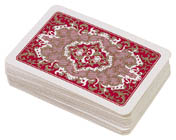Poker strategy essays
The Combinatorial Function
By
Bud Kelly
November 2016
The combinatorial function is the foundation of
all poker probability calculations. It is not difficult
to learn, and with a little practice you can have
it on hand as a valuable tool in your toolbox.
 In
plain language, the combinatorial function tells you
how many ways you can arrange m objects, taken n at
a time. (The order of the objects does not count.)
For example, how many ways can you arrange 52 cards,
taken 2 at a time, like the down cards in Texas Hold'em.
Here is the math:
In
plain language, the combinatorial function tells you
how many ways you can arrange m objects, taken n at
a time. (The order of the objects does not count.)
For example, how many ways can you arrange 52 cards,
taken 2 at a time, like the down cards in Texas Hold'em.
Here is the math:
C(n, m) = n! / m! (n-m)!
If you are not mathematically inclined, don't let
the mathematical notation intimidate you. In fact,
it turns out to be quite simple in practice. The only
thing that might be a bit unfamiliar to you is the
"!" symbol, which is used in mathematics to signify
the factorial function.
The factorial function means that you multiply the
number by every number preceding it, all the way down
to 1.
For example, 3! would be 1 x 2 x 3, or 6.
As another example, 6! would be 1 x 2 x 3 x 4 x 5
x 6, or 720.
You can see that any reasonably large number will
become huge when the factorial function is applied,
but let not your heart be troubled. As it turns out,
using the combinatorial function generally allows
you to cancel out a lot of the multiplication and
make the calculation simple enough to do in your head.
That is, with a little practice.
Let's take the example of how many ways you can arrange
52 cards, taken 2 at a time, like the down cards in
Texas Hold'em. In effect, how many different down
card hands are possible. Here n = 52, and m = 2. So
the combinatorial function calculation is:
C (52, 2) = 52! / 2! (52-2)!
C (52, 2) = 52! / 2! (50)!
C (52, 2) = 1 x 2 x 3 …..x 49 x 50 x 51 x 52 / 1
x 2 (1 x 2 x 3… x 49x 50)
Now you can simplify this by cancelling out numbers
common to the numerator and denominator:
C(52, 2) = 51, x 50 / 1 x 2
C(52, 2) = 1,326
Even if you are averse to doing the math, just remember
the number 1,326, because it is the number of possible
2 card hands you can be dealt in Texas Hold'em.
1,326 Possible Starting Hands
Since card suits all have the same rank in poker,
many of these hands are equivalent to each other.
(For example, any pair of queens has the same rank
as any other pair of queens, no matter what suits
they are.) As it turns out, though there are 1,326
possible starting hands, there are only 169 non-equivalent
hands. That makes things a little simpler.
Of
these 169 equivalent hands, 13 are pairs.
Of these 169 equivalent hands, 78 are non- suited.
Of these 169 equivalent hands, 78 are suited.
Note that 13 + 78 + 78 = 169.
13 Pairs, 78 Non-Suited, 78 Suited.
Just memorizing this will give you a good grasp of
what the prospects are for any starting hand you are
dealt. But a better grasp can be gained by memorizing
the probability of being dealt various hands:
Probability of a pair, any pair, 1 in 17.
Probability of 2 suited cards, any suit, 4 in 17.
Probability of 2 unsuited cards, any suit, 12 in
17.
Note that 1/17 + 4/17 + 12/17 = 17/17, representing
all of the possibilities.
Pairs 1/17, suited 4/17, unsuited 12/17.
You can see that being dealt a pair is fairly fortunate.
So is being dealt two suited cards. Between these
two possibilities, and you are enjoying one of the
top 5 out of 17 hands. Prospects will be good, but
it all depends on the specific cards, the number of
players, and of course the cards that they have been
dealt.
So, unfortunately it's not that simple. The actual
cards you have been dealt, the number of players,
and the cards that they have been dealt create enormous
complications in evaluating the prospects of winning
with your hand.
Fortunately, a number of poker gurus, theorists,
and people who have spent their lives playing Texas
Hold'em, have published systems of evaluation. These
systems differ slightly from author to author, but
knowing something about most of them, and everything
about any one of them, will put you in a good position
to evaluate your prospects and guide your decisions
in the opening round of betting.
But of course, at the highest levels, Texas Hold'em
is not about playing cards but about playing people.
It's "a game of people, played with cards." That's
where the greatest challenge lies, as well as the
greatest potential rewards.
Note:
Bud Kelly is a writer of fiction, non-fiction,
magazine articles, news columns, poetry, songs, music,
and jokes. You can see some of his work on Nook and
Kindle. If there's anything you would like written
for your website, contact us via the link on the menu
and we will put you in touch with Bud.
Home|Contact
us
©2005-present The Holdem
Lounge. All rights reserved.